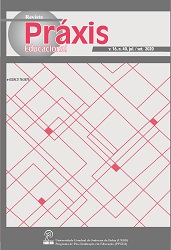THE RIGHT TO PLAY: A NECESSITY FOR CHILDREN, A POTENTIAL FOR SCHOOL AND THE CITY
DOI:
https://doi.org/10.22481/praxisedu.v16i40.6899Keywords:
Childreen, City, School, Right to playAbstract
The main question addressed in this article is: why and how should child play be considered an important parameter in urban policies? A possible answer to this problem is found throughout the text. I would like to begin by drawing the most recent evolution (or rather involution) of urban structure and organization, emphasizing how it defines an environment that is forbidden and hostile to children, unless they are accompanied by adults; I will summarize the impact of this environment on the game and therefore on the development of children, accentuating the different characteristics of spatial mobility in children and adults, and the extreme danger of isolating children from the experience of danger. I will propose a radical alternative to urban policy in which children and their play are the main focus, rather than a marginal problem and not known to be considered only as a later reflection, and I will present some concrete cases in those where such an alternative was put into practice by children and politicians together, and its effects were tested and evaluated. In conclusion, similar experiences seem to justify a moderate amount of hope for the future of our cities, despite their worrying current conditions.
Downloads
Metrics
References
BARALDI, C., MAGGIONI, G.(eds.). Una città con i bambini, progetti ed esperienze del Laboratorio di Fano, Roma: Donzelli Editore, 2000.
BATESON, G., The Message “This Is Play”, New York: Josiah Macy Jr. Foundation, 1956.
BAUMAN, Z., The individualized society, Cambridge: Polity Press, 2001.
BENCIVENGA, E. Giocare per forza. Critica alla società del divertimento, Milano: Mondadori, 1995.
BENCIVENGA, E. Tre dialoghi, Torino: Bollati Boringhieri, 1988.
BLAKELY, K. S. ‘Parents’ conceptions of social dangers to children in the urban environment’ Children’s Environments 11, 1994. p. 16-25.
BOZZO, L. ‘Il gioco e la città’, Paesaggio urbano 2, 1995, p. 30-33.
BRUNER, J. S. ‘Nature and uses of immaturity’, in J. S. Bruner, A. Jolly, K. Silva (eds.), Play. Its role in development and evolution, New York: Basic Books, 1976.
CAILLOIS, R. Les jeux et les hommes, Paris: Gallimard, 1967.
CHAWLA, L. Growing up in an urbanizing world, Paris/London: Unesco Publishing/Earthscan, 2001.
DE SAINT-EXUPÉRY, A. Le Petit Prince, Paris: Gallimard, 1943.
GARLING, T., VALSINER, J. (eds.): Children within environment: Toward a psychology of accident prevention, New York: Plenum Press, 1985.
GARVEY, C. Play, Cambridge: Harvard University Press, 1977.
GERMANOS, D. ‘La relation de l'enfant à l'espace urbain: perspectives educatives et culturelles’, Architecture & Comportement 2, 1995, p. 54-63.
GOMBRICH, E. H. Meditations on a hobby horse and other essays on the theory of art, London: Phaidon, 1971.
HART, R. Children’s Participation: The Theory and Practice of Involving Young Citizens in Community Development and Environmental Care, London: Earthscan Publication Limited, 1997.
HILLMAN, M. (ed.). Children, transport and the quality of life, London: Policy Studies Institute, 1993.
HUIZINGA, J. Homo Ludens, Amsterdam: Panteon Verlag, 1939.
KLINE, S. ‘The promotion and marketing of toys: Time to rethink the paradox?’. In: PELLEGRINI, A. The future of play theory, Albany: State of New York University Press, 1995.
LOCKE, J. Some thoughts concerning education, Indianapolis/Cambridge: Hackett Publishing Company (orig. ed. 1693), 1996.
LYNCH, K. ‘The Spatial World of the child’, in W. Michelson, S.V. Levine, E. Michelson (eds.), The child in the city: Today and tomorrow, Toronto: Univerity of Toronto Press.
MANN, M. Incoherent empire, London: Verso Books, 1979/2003.
MARILLAUD, J. ‘Jeu et securité dans l'espace pubblic’, Architecture & Comportement 7, 1991, p. 137-145.
MUMFORD, L. ‘La pianificazione per le diverse fasi della vita’, Urbanistica 1, 1945, p. 7-11.
PIAGET, J. La formation du symbole chez l’enfant, Neuchâtel: Delachaux et Niestlé, 1945.
PREZZA, M., ALPARONE, F. R., RENZI, D., PIETROBONO, A. Social Participation and Independent Mobility in Children: The Effects of Two Implementations of ‘‘We Go to School Alone’’, Journal of Prevention & Intervention in the Community, 38, 2010, p. 8–25.
PREZZA, M., PILLONI, S., MORABITO, C., SERSANTE, C., ALPARONE, F. R. ‘La mobilità autonoma dei bambini nel contesto urbano e il cortile, il parco e la strada privata come spazi di gioco’, Psicologia della salute 3, 2000, p. 81-97.
RISSOTTO, A., TONUCCI, F. ‘Freedom of Movement and Environmental Knowledge in Elementary School Children’, Journal of Environmental Psychology 22, 2002, p. 65-77.
SHAW, B., WATSON, B., FRAUENDIENST, B., REDECKER, A., JONES, T., HILLMAN, M. Children’s independent mobility: a comparative study in England and Germany (1971 - 2010), London: Policy Studies Institute, 2013.
SPINKA, M., NEWBERRY, R. C., BEKOFF, M. ‘Mammalian play: Training for the unexpected’, Quarterly Review of Biology 76, 2001, p. 141-168.
SUTTON-SMITH, B. The ambiguity of play, Cambridge: Cambridge University Press, 1997.
SUTTON-SMITH, B. Toys as culture, New York: Gardner Press, 1986.
TAYLOR, A . F., WILEY, A., KUO, F. E., SULLIVAN, W. C. ‘Growing up in the Inner City: Green Spaces as Places to Grow’ Environment and Behavior 30, 1998, p. 3-27.
TONUCCI, F. La città dei bambini, Bari: Laterza, 1996.
TONUCCI, F. Se i bambini dicono: adesso basta!, Bari: Laterza, 2002.
TONUCCI, F., RISSOTTO, A., ‘Why Do We Need Children's Participation? The Importance of Children's Participation in Changing The City’, Journal of Community and Applied Social Psychology 11, 2001, p. 407-419.
VYGOTSKY, L. S. ‘Play and its role in the mental development of the child’, Soviet Psychology 12, VI, 1966.
Downloads
Published
How to Cite
Issue
Section
License
You are free to:
Share - copy and redistribute the material in any medium or format; Adapt - remix, transform, and build from the material for any purpose, even commercially. This license is acceptable for Free Cultural Works. The licensor cannot revoke these freedoms as long as you follow the terms of the license.
Under the following terms:
Attribution - You must appropriately give credit, provide a link to the license, and indicate if any changes have been made. You may do so in any reasonable way, but not in a way that suggests that you or your use is endorsed by the licensor.
There are no additional restrictions - You cannot apply legal terms or technological measures that legally restrict others to make any use permitted by the license.










